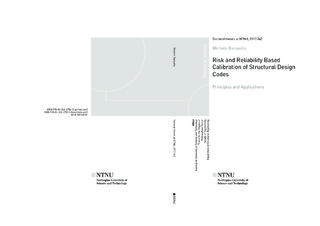| dc.contributor.advisor | Köhler, Jochen | |
| dc.contributor.advisor | Sørensen, John Dalsgaard | |
| dc.contributor.author | Baravalle, Michele | |
| dc.date.accessioned | 2018-02-15T14:27:23Z | |
| dc.date.available | 2018-02-15T14:27:23Z | |
| dc.date.issued | 2017 | |
| dc.identifier.isbn | ISBN 978-82-326-2753-0 | |
| dc.identifier.issn | 1503-8181 | |
| dc.identifier.uri | http://hdl.handle.net/11250/2485103 | |
| dc.description.abstract | Structures and infrastructures are essential for most societal activities and are required to be safe, as well as economically and environmentally sustainable. At the same time, societal resources of all kinds are limited. Thus, it is of vital importance that these resources are allocated optimally, not only financially but also in terms of reduction of risk to life. A logical point to start from in approaching this complex optimization problem is with our building codes that constitute the primary decision support for structural engineers. Therefore, it is essential that the building codes are optimised or calibrated for this perspective. The design with optimised codes balances investments into safety and expected adverse consequences.
This work contributes to the development of theoretical methods for code making. The aim is to reduce the subjectivity involved in the process and, consequently, to make more solid, transparent and optimal decisions.
The primary objective is to provide rational methods, frameworks and principles for optimizing the design requirements. For this purpose, in the first part of the work, code optimization is seen as a decision problem under risk, where society is the rational decision maker. Indeed, the outcomes of a decision, such as the assignment of safety factor values, are not known with certainty. Therefore, the basis is exclusively taken from the normative decision theory, which provides a strategy ensuring minimal use of resources over time. Three main methods are proposed: i) a generic and comprehensive risk-based calibration approach for calibrating the design requirements, ii) a generic representation of target values for structural reliability and iii) a method for estimating the implicit safety level of existing optimal codes.
The secondary objective is to address the current code calibration and code-related tasks and to provide objective bases for decision making. Four tasks are addressed: i) the calibration of simplified safety formats for the design of common timber structures, ii) the probabilistic modelling of the wind climate for code calibration, iii) the discussion of the optimality of designing extraordinary structures using common design codes, iv) the assessment and eventual re-calibration of the partial safety factors in the Eurocodes.
In conclusion, the present work represents a substantial step forward towards a more rationally based code making. The methods proposed in the first part might support code committees in the fundamental decision of selecting target reliabilities and differentiating them among structures with diverse characteristics. The second part proposes solutions to current calibration tasks applying existing methodologies. | nb_NO |
| dc.language.iso | eng | nb_NO |
| dc.publisher | NTNU | nb_NO |
| dc.relation.ispartofseries | Doctoral theses at NTNU;2017:342 | |
| dc.relation.haspart | Paper 1: Baravalle, Michele; Köhler, Jochen. A Risk-Based Approach for Calibration of Design Codes.
- Is not included due to copyright | nb_NO |
| dc.relation.haspart | Paper 2: Baravalle, Michele; Köhler, Jochen. Generic Representation of Target Values for Structural Reliability.
- Is not included due to copyright | nb_NO |
| dc.relation.haspart | Paper 3: Baravalle, Michele; Kohler, Jochen. A framework for estimating the implicit safety level of existing design codes. I: Proceedings of the 12th International Conference on Structural Safety and Reliability (ICOSSAR2017), Vienna, Austria. : Grafisches Zentrum HTU GmbH 2017.
- Is not included due to copyright | nb_NO |
| dc.relation.haspart | Paper 4: Baravalle, Michele; Mikoschek, Michael; Colling, François; Kohler, Jochen. Calibration of simplified safety formats for structural timber design. Construction and Building Materials 2017 ;Volum 152. s. 1051-1058.
https://doi.org/10.1016/j.conbuildmat.2017.06.155 | nb_NO |
| dc.relation.haspart | Paper 5: Baravalle, Michele; Kohler, Jochen. On the probabilistic representation of the wind climate for calibration of structural design standards. Structural Safety 2018 ;Volum 70. s. 115-127.
https://doi.org/10.1016/j.strusafe.2017.10.012 | nb_NO |
| dc.relation.haspart | Paper 6: Baravalle, Michele; Kohler, Jochen. Risk and reliability based calibration of design codes for submerged floating tunnels. Procedia Engineering 2016 ;Volum 166. s. 247-254.
This is an open access article under the CC BY-NC-ND license
https://doi.org/10.1016/j.proeng.2016.11.547 | nb_NO |
| dc.title | Risk and Reliability Based Calibration of Structural Design Codes: Principles and Applications | nb_NO |
| dc.type | Doctoral thesis | nb_NO |
| dc.subject.nsi | VDP::Teknologi: 500::Bygningsfag: 530::Konstruksjonsteknologi: 533 | nb_NO |
| dc.description.localcode | Digital full text not available | nb_NO |

